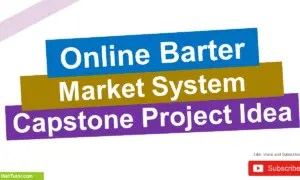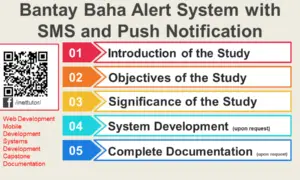Smart Transportation Systems Project Ideas
Introduction
Table of Contents
In today’s fast-paced urban environment, the need for efficient transportation has never been greater. Traffic congestion, unreliable public transit, and the growing environmental impact of current systems pose significant challenges. To address these issues, the development of a Smart Transportation System is essential.
Objective
The primary goal of this project is to create a smart transportation system that improves urban mobility. By utilizing real-time data, Internet of Things (IoT), and Artificial Intelligence (AI), the system aims to streamline transportation and offer more sustainable solutions.
Problem Statement
Cities around the world face increasing levels of traffic congestion, inefficient public transport services, and negative environmental impacts. These challenges not only affect the daily commute but also contribute to higher emissions, reduced productivity, and public dissatisfaction. A solution is needed that can intelligently manage traffic, optimize transport routes, and minimize environmental damage.
Scope
This project focuses on the urban transportation ecosystem, covering major areas such as road networks, public transport systems, and pedestrian flow. By integrating smart technology, the system will offer real-time traffic insights, optimize public transport schedules, and enhance pedestrian safety and convenience.
Expected Impact
The smart transportation system is expected to reduce traffic congestion significantly, provide a smoother and more enjoyable commute for residents, and optimize transportation routes for better efficiency. In addition, it will contribute to reducing the environmental footprint of city transport by promoting eco-friendly practices and supporting the use of electric vehicles.
By tackling these challenges with smart solutions, this project will help reshape the future of urban transportation, making cities cleaner, safer, and more efficient for everyone.
System Overview
A Smart Transportation System relies on cutting-edge technology to improve urban mobility, ease traffic congestion, and enhance the overall commuting experience. The system is designed to intelligently manage traffic flow, optimize public transport, and provide real-time updates to users, making it a valuable tool for both commuters and city planners.
Key Components:
- IoT Sensors: Internet of Things (IoT) sensors play a critical role in this system by gathering real-time data on various aspects of urban transportation. These sensors can monitor traffic flow, vehicle density, and even environmental factors like air quality. By placing IoT sensors strategically across the city—on traffic lights, roads, and public transport systems—this data is collected and transmitted to a central platform for analysis. This information helps in providing real-time traffic updates and adjusting signals dynamically to optimize traffic flow.
- Mobile Application: The mobile application serves as the interface between users and the smart transportation system. It allows users to book tickets for public transport, get real-time route suggestions, and access live updates on traffic conditions. The app also provides personalized recommendations for alternate routes during heavy traffic or road closures, making the commuting experience more efficient. Additionally, the app can notify users of delays in public transport, ensuring they have up-to-date information at their fingertips.
- AI Algorithms: Artificial Intelligence (AI) algorithms form the brain of the smart transportation system. They analyze data from IoT sensors to predict traffic conditions and optimize routes for drivers and public transport alike. AI can learn from past traffic patterns to forecast peak congestion times and suggest the best possible routes. These algorithms also help in managing emergency vehicles by adjusting traffic lights to clear a path for them in real-time, ensuring a faster and safer response.
- Public Transport Integration: One of the most significant aspects of this system is the real-time integration of public transport. Buses, trains, and other modes of public transportation are equipped with GPS trackers to provide commuters with live location updates. This feature allows users to track the exact position of public transport vehicles, check seat availability, and estimate arrival times. This integration helps to make public transport more reliable and appealing to commuters.
Key Technologies:
- Internet of Things (IoT): IoT technology connects devices like sensors and cameras across the city’s infrastructure. It enables the seamless collection of data on traffic, weather, and vehicle usage, which is crucial for making informed decisions in real time. With IoT, the transportation system can monitor and react to changing conditions instantaneously, improving overall efficiency.
- Artificial Intelligence (AI): AI powers the decision-making process behind route optimization, traffic prediction, and transport management. By processing vast amounts of data in real time, AI can provide accurate predictions and recommendations, ultimately reducing travel time and making roads safer.
- Data Analytics: Data analytics is essential for understanding patterns in traffic flow, public transport usage, and commuter behavior. By analyzing historical and real-time data, the system can identify problem areas and propose solutions like route diversions or public transport enhancements. Data analytics helps cities manage resources better, plan infrastructure improvements, and ensure the smart transportation system evolves based on user needs.
- Geographic Information Systems (GIS): GIS technology is used to map out road networks, public transport routes, and pedestrian zones. It helps the system visualize traffic congestion hotspots and make accurate predictions for route suggestions. By integrating GIS with real-time data, the transportation system can display live traffic maps, making it easier for users to plan their trips and avoid delays.
Project Ideas
Here are 15 unique project ideas related to Smart Transportation Systems, along with descriptions and suggested development tools:
- Adaptive Smart Traffic Light System
Description: A traffic light system that adapts dynamically to real-time traffic conditions using AI and IoT. It prioritizes busy lanes and provides real-time emergency vehicle clearance. Tools: Python for AI (scikit-learn or TensorFlow), IoT devices (Raspberry Pi/Arduino), OpenCV for vehicle detection, MQTT for real-time messaging.
- AI-Powered Smart Carpool Matching System
Description: A platform that intelligently matches people traveling to similar destinations, optimizing routes and reducing the number of vehicles on the road. Tools: Python (machine learning), React.js for the frontend, Node.js for the backend, Firebase for real-time matching, Google Maps API for route optimization.
- Augmented Reality (AR) Public Transit Assistance
Description: An AR-powered app that guides users in real-time while navigating public transit stations, showing routes, bus/train schedules, and exit gates in a 3D overlay. Tools: Unity with ARKit/ARCore, Swift or Kotlin for mobile app development, Google Maps API for real-time transit data, Node.js for backend.
- Real-Time Traffic Pollution Control System
Description: An IoT-based system that measures pollution levels in real-time across urban areas and diverts traffic from high-pollution zones to cleaner routes. Tools: IoT sensors (e.g., air quality sensors), Python for data analysis, Flask for the backend, React for the dashboard, Google Maps API for routing.
- Smart Public Bike Redistribution System
Description: A system that optimizes the redistribution of public bikes across different stations using AI, ensuring an even distribution based on usage patterns. Tools: Python (AI/ML for predictions), MongoDB for database, React.js for user interface, Node.js for backend, IoT-enabled bike locks for real-time tracking.
- Blockchain-Based Ride-Hailing Platform
Description: A decentralized ride-hailing service using blockchain to enhance trust, security, and transparency between drivers and passengers. Payments and ride histories are stored securely on the blockchain. Tools: Ethereum (Solidity for smart contracts), React.js for frontend, Node.js for backend, Metamask API for blockchain wallet integration.
- Autonomous Intersection Management System
Description: A system that uses AI to manage intersections by communicating with connected vehicles, ensuring optimal flow and minimizing wait times without the need for traffic lights. Tools: V2X communication, Python for AI and algorithms, IoT modules (ESP8266), Node.js for backend, GIS tools for intersection mapping.
- Crowdsourced Pedestrian Safety Monitoring
Description: A mobile app that allows users to report unsafe pedestrian crossings, potholes, or traffic hazards. It uses crowdsourced data to build a safer pedestrian experience. Tools: React Native for mobile app, Node.js for backend, Firebase for real-time data sync, Google Maps API for hazard mapping.
- Smart Parking Slot Reservation System
Description: A system that enables drivers to reserve parking spots in real-time based on location and availability, ensuring smoother parking experiences in busy areas. Tools: IoT sensors (for parking space detection), Python for real-time booking algorithms, Node.js for backend, React.js for frontend, MongoDB for parking data.
- Drone-Assisted Traffic Monitoring System
Description: A drone-based system that monitors real-time traffic from above, providing live feeds and data analysis to assist traffic management systems during peak hours or emergencies. Tools: Drone SDK (DJI/Parrot SDK), Python for video feed analysis (OpenCV), Flask for backend processing, React.js for live dashboard, Google Maps API for traffic mapping.
- AI-Driven Predictive Maintenance for Public Transport
Description: A system that uses AI to predict when buses, trains, or other public transport vehicles will need maintenance based on sensor data, reducing breakdowns and improving service reliability. Tools: IoT sensors, Python (TensorFlow or scikit-learn for predictive maintenance), Node.js for backend, React.js for admin dashboard, MongoDB for historical data storage.
- Smart Road Pricing System
Description: A system that dynamically adjusts toll prices based on real-time traffic data, time of day, and environmental conditions to encourage better road usage and reduce congestion. Tools: Python for pricing algorithms, Flask for backend, IoT-enabled toll gates, Google Maps API for real-time traffic data, React.js for user interface.
- Virtual Bus Stops for Dynamic Public Transport Routing
Description: A system that adjusts bus routes in real-time by creating virtual bus stops based on passenger demand and current traffic conditions, optimizing routes for efficiency. Tools: Python for AI-based route prediction, Firebase for real-time passenger data, Node.js for backend, React Native for mobile app, Google Maps API for routing.
- AI-Based Traffic Incident Detection and Alert System
Description: A system that uses AI and real-time traffic camera feeds to detect accidents, stalled vehicles, or road obstructions and automatically alerts the authorities. Tools: OpenCV with Python for video feed analysis, Flask for backend processing, React.js for live traffic incident dashboard, Firebase for real-time alerts.
- Eco-Friendly Route Optimization System
Description: A system that suggests eco-friendly routes for drivers and public transport vehicles, minimizing fuel consumption and emissions by considering terrain, traffic, and road types. Tools: Python (AI/ML for route suggestions), Google Maps API for real-time traffic and terrain data, React.js for user interface, MongoDB for storing historical route data.
Conclusion
Smart transportation systems have the potential to revolutionize urban mobility, offering practical solutions to some of the most pressing challenges cities face today. By leveraging technologies such as IoT, AI, and mobile applications, we can significantly reduce traffic congestion, improve the efficiency of public transport, and enhance commuter experiences. These systems also contribute to a cleaner environment by optimizing routes and reducing emissions, making urban transportation more sustainable and efficient for future generations.
You may visit our Facebook page for more information, inquiries, and comments. Please subscribe also to our YouTube Channel to receive free capstone projects resources and computer programming tutorials.
Hire our team to do the project.


